Special Report
15 Cities With the Most High-Tech Jobs

Published:
Last Updated:

Economic growth has always been at the forefront of political discourse, but likely even more so since the Great Recession. How to achieve widespread prosperity has been a matter of heated debate. With the breakneck pace of technological development that has affected every aspect of our lives, many argue that advanced industries are essential to economic prosperity.
In a recent update to its 2015 report America’s Advanced Industries: What They Are, Where They Are, and Why They Matter, the Brookings Institution’s Metropolitan Policy Program argues that the key to rebuilding the nation’s economy is in promoting the development of advanced industries. Advanced industries are characterized by heavy investment in research and development (R&D) and high employment in science, technology, engineering, and mathematics (STEM) fields. Advanced industries include manufacturing industries such as automobile and aircraft manufacturing, energy industries such as oil and gas extraction, and high-tech service industries such as computer systems design and software, and more.
[in-text-ad]
To identify cities with the largest share of advanced industry jobs, 24/7 Wall St. used data from the most recent update to the Brookings report. With 31.2%, the San Jose-Sunnyvale-Santa Clara metro area has the largest share of employees working in advanced industries.
Click here to see the 15 cities with the most high tech jobs.
There are 50 industries in total that meet the criteria for being considered advanced: industries that spend at least $450 per employee on R&D, and have at least 20% of workers employed in STEM roles. According to Mark Muro, senior fellow at the Metropolitan Policy Program at Brookings, these attributes reflect “inputs that lead to particularly high quality, high impact growth.” These industries “are highly productive, highly innovative, and they determine our global competitiveness and our balance of trade,” he said.
One way advanced industries can contribute to economic growth is through high wages. In 2015, the average wage for all U.S. employees was $53,060. Workers employed in advanced industries were paid much more. The average employee of an advanced industry was paid $95,500, over $40,000 more than the average American worker.
Advanced industries also tend to attract a high level of venture capital investment. In cities such as San Francisco, Boston, and San Jose, the average venture capital deal made in the latest fiscal quarter was worth more than $9 million, among the most of any metro. According to Muro, companies in advanced industries also “generate innovations that flow through the economy.” Of the 15 cities with the largest shares of advanced industry employees, 11 were awarded more patents per capita in 2015 than the national average of 49 per 100,000 Americans.
To identify cities with the most advanced jobs, 24/7 Wall St. used data from the most recent update to the 2015 Brookings report on advanced industries, America’s advanced industries: New trends. Brookings identified 50 four-digit NAICS industries that meet its criteria of advanced industries: industries that spend at least $450 per worker on R&D annually and that employ at least 20% of their workforce in STEM-related roles.
The share of workers in advanced industries, advanced industries’ contribution to output, average annual wage, and employment and output figures by industry came from the Brookings report. Data on patents by metropolitan area are for 2015 and from the U.S. Patent and Trademark Office. The number of venture capital deals and their value came from the National Venture Capital Association and are as of the fourth quarter of the 2016 fiscal year. Seasonally adjusted December 2016 unemployment rates came from the Bureau of Labor Statistics. Data on population and educational attainment came from the U.S. Census Bureau’s American Community Survey and are for 2015.
These are the 15 cities with the most high-tech jobs.

15. Portland-Vancouver-Hillsboro, OR-WA
> Advanced industries, share of employment: 11.0%
> Advanced industries, share of output: 37.1%
> Annual avg. wage: $55,807
> Largest advanced industry: Semiconductors
Advanced industries conduct significant R&D and employ relatively large numbers of STEM workers. As part of advanced industries, tech companies are extremely valuable to an area’s economy, and require workers with advanced skill sets. In the Portland metropolitan area, such advanced industries — consisting mainly of semiconductor manufacturing and software development companies — account for 11% of jobs.
Global semiconductor manufacturer Intel Corporation operates in the region, for example. There are eight Intel locations in Hillsboro alone, including one of the company’s largest fabrication facilities. Despite large scale layoffs announced last year, Intel remains Oregon’s largest private employer.
[in-text-ad]

14. Ogden-Clearfield, UT
> Advanced industries, share of employment: 11.1%
> Advanced industries, share of output: 19.9%
> Annual avg. wage: $42,567
> Largest advanced industry: Aircraft products & parts
More than one in 10 workers in the Ogden-Clearfield metro area work in an advanced industry. While other metropolitan economies on this list have thriving high tech entrepreneurial climates, Ogden’s advanced industries are largely centered around heavy manufacturing. There were just two venture capital deals in Ogden in the latest fiscal quarter, among the least of any major city.
Ogden’s largest advanced industry is the aircraft product and parts manufacturing, which employs some 4,120 aircraft manufacturing workers. Ogden lis home to the Hill Air Force Base, which is the area’s largest employer.
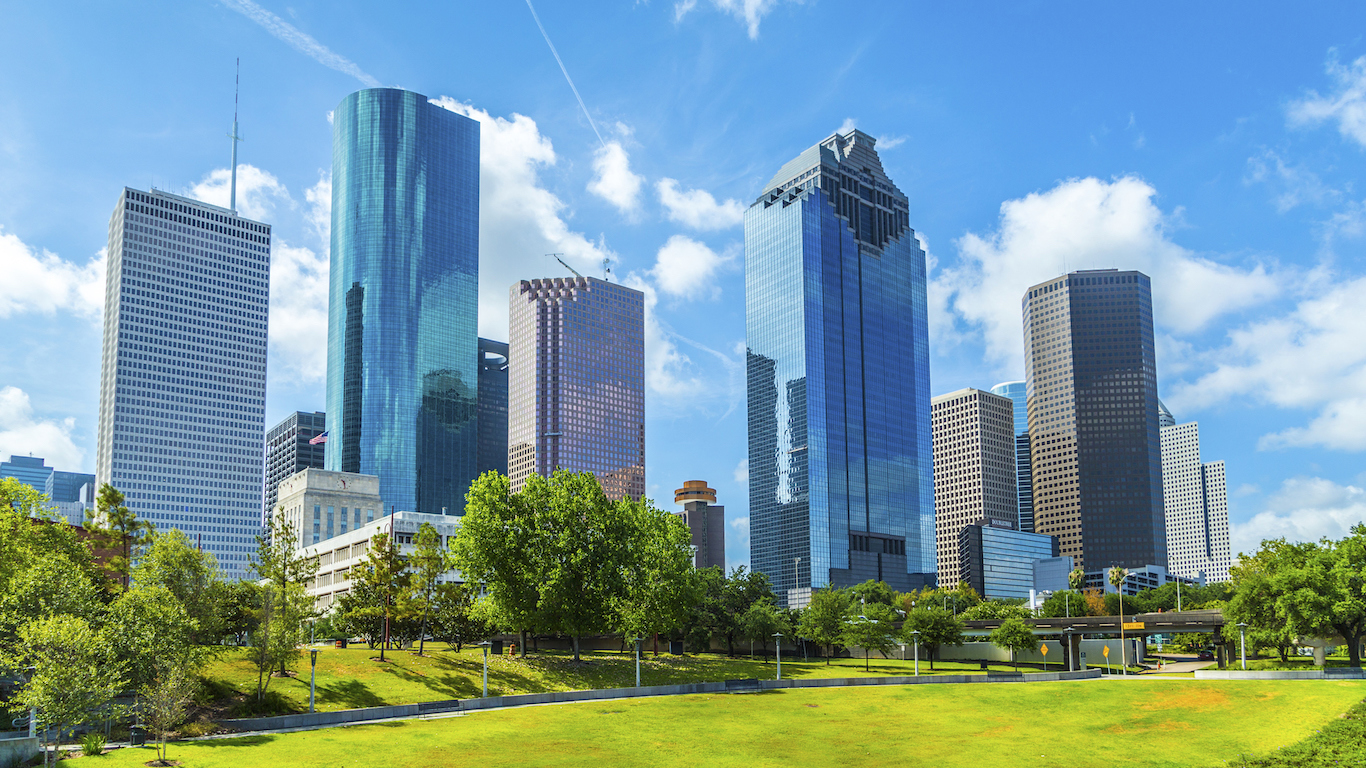
13. Houston-The Woodlands-Sugar Land, TX
> Advanced industries, share of employment: 11.9%
> Advanced industries, share of output: 37.1%
> Annual avg. wage: $66,232
> Largest advanced industry: Engineering
Much of the advanced industry in the Houston-The Woodlands-Sugar Land metro area is related to the city’s massive energy sector. Nearly half of the metro’s tech employees work in either the engineering, oil and gas extraction, or mining machinery industries. As a result, advanced industry work in Houston is more lucrative than in nearly any other city. The average advanced industry wage in the area of $128,044 a year is nearly double the average wage across all industries in the area and the fifth highest compared with metro area advanced industry wages. Advanced industries account for 37.1% of area GDP, the second largest share of any major city.

12. Provo-Orem, UT
> Advanced industries, share of employment: 12.2%
> Advanced industries, share of output: 22.1%
> Annual avg. wage: $41,476
> Largest advanced industry: Computer systems design
Provo-Orem is one of three Utah metro areas comprising the Silicon Slopes region, in which more than one in 10 jobs are in advanced industries. Most advanced jobs in Provo are in high-tech industries such as computer systems design, software products, data processing, or internet publishing — and many companies in these industries are startups. Key infrastructural advantages have likely helped support the city’s entrepreneurial climate. For example, Google Fiber, which provides high-speed internet to small businesses in the city for as little as $70 a month, may have helped attract talent and investment to the area. In the latest fiscal quarter, Provo entrepreneurs closed a total of 10 venture capital deals worth an average of $8.5 million, among the highest average investments of any city.
[in-text-ad-2]
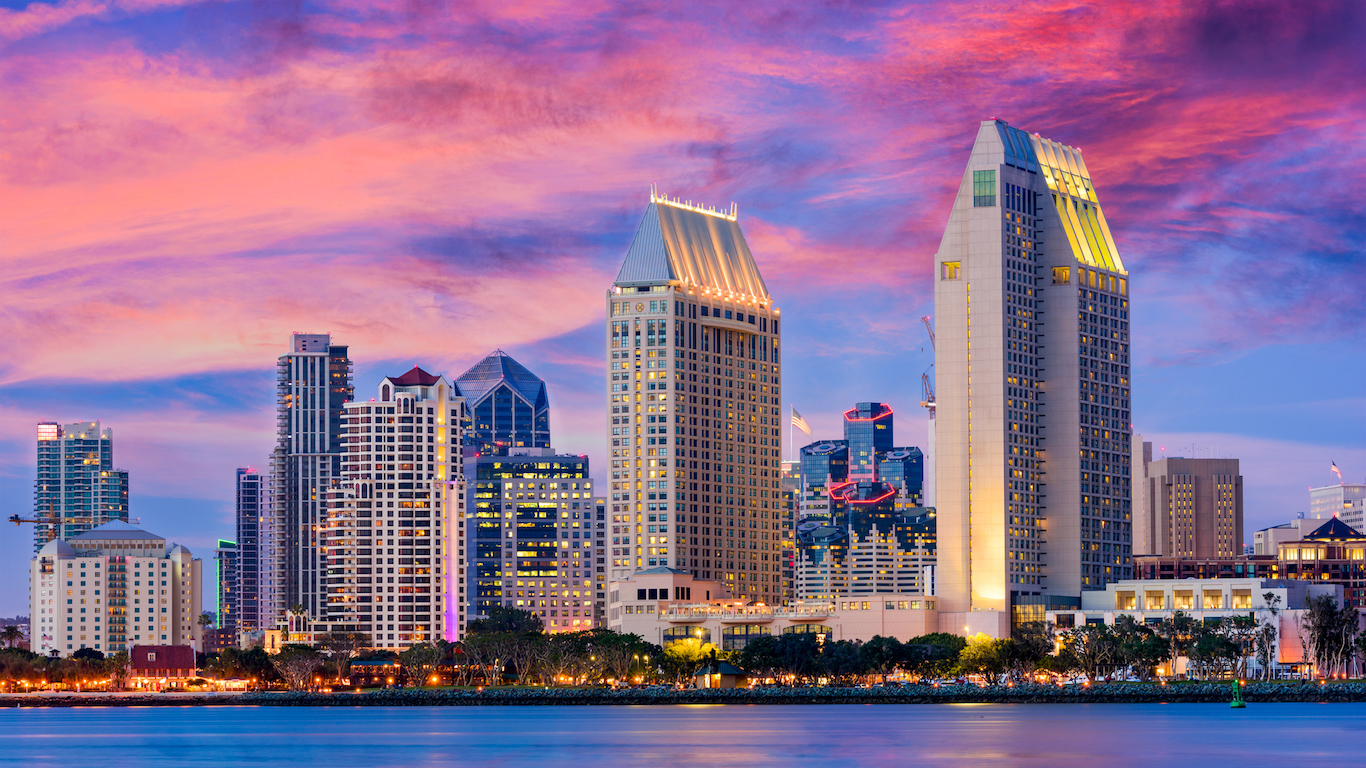
11. San Diego-Carlsbad, CA
> Advanced industries, share of employment: 12.3%
> Advanced industries, share of output: 21.4%
> Annual avg. wage: $61,462
> Largest advanced industry: R&D Services
An estimated 12.3% of employees in the San Diego-Carlsbad metro area are employed in advanced industries, a larger share than in all but 10 metro areas. Some of the most notable thriving businesses in the city are small biotechnology companies clustered within Torrey Pines and Sorrento Valley. A little more than half of the $1.3 billion venture capital investment in San Diego in 2015 went to biotech companies. Nearly 34,000 San Diego residents work in R&D services, more than in any other advanced industry in the city. The high investment and employment in R&D has helped San Diego foster one of the most innovative workforces in the country. San Diego residents were awarded 5,460 patents in 2015, the third most of any metro area when adjusted for population.
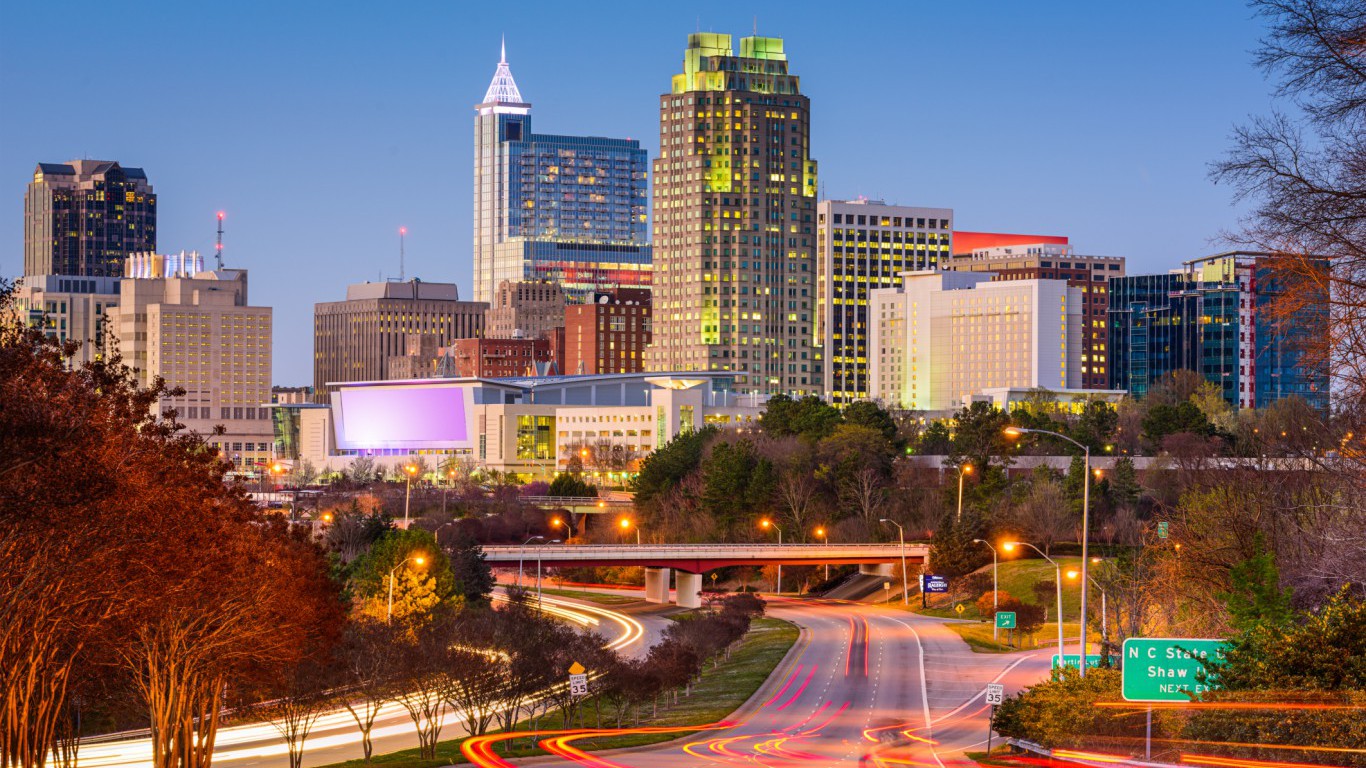
10. Raleigh, NC
> Advanced industries, share of employment: 12.5%
> Advanced industries, share of output: 24.8%
> Annual avg. wage: $54,744
> Largest advanced industry: Computer systems design
Many of the metro areas that support advanced industries have a high tech hub that is connected to the region’s research universities. Research Triangle Park, which was first opened in the 1950s, has since grown to include more than 200 companies and employ 50,000 people — helping to transform Raleigh from a textile- and agriculture-based economy to an international high tech center.
Advanced industries account for roughly 25% of Raleigh’s GDP, one of the largest shares of any city. Between 2013 and 2015, the GDP generated by Raleigh’s advanced industries grew at an average rate of 9% annually, faster than in any city other than Provo-Orem, Utah.
[in-text-ad]
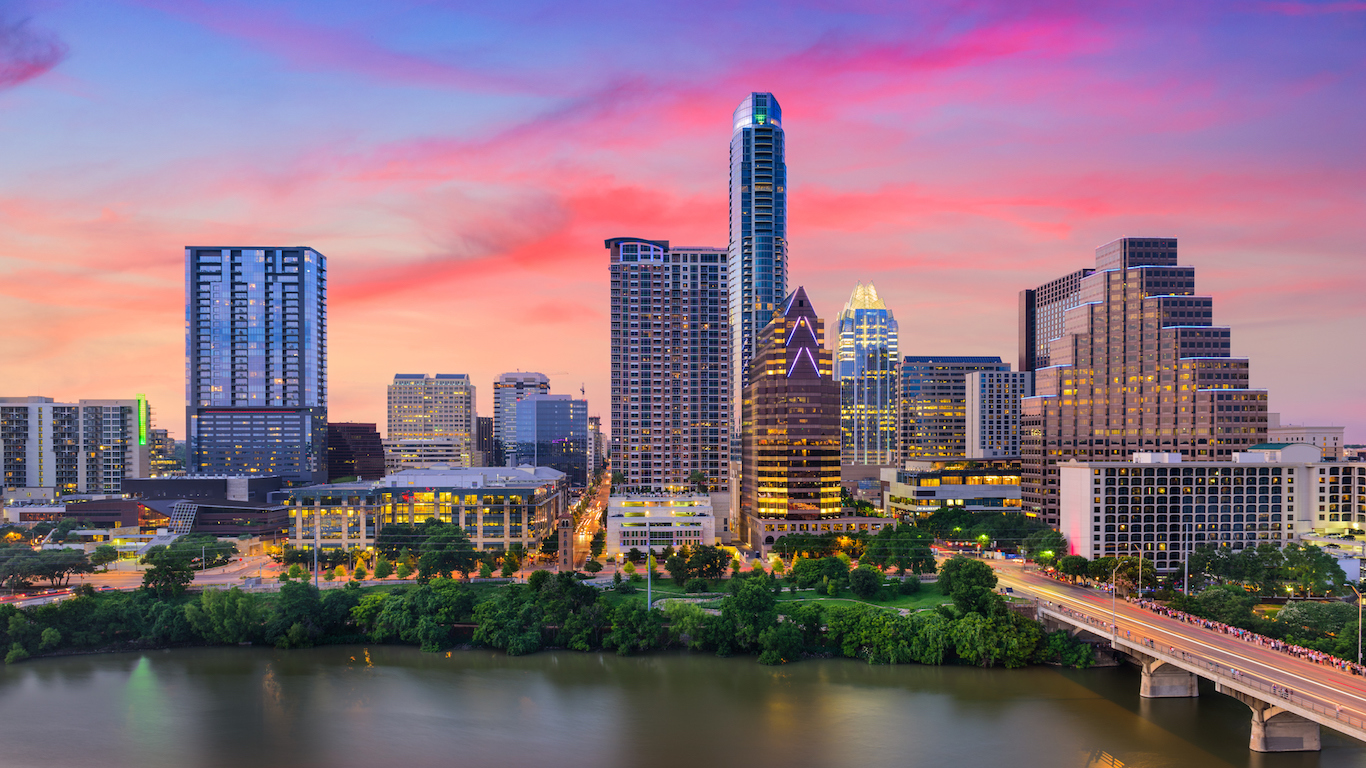
9. Austin-Round Rock, TX
> Advanced industries, share of employment: 13.1%
> Advanced industries, share of output: 25.5%
> Annual avg. wage: $55,909
> Largest advanced industry: Computer systems design
As is the case in all but a few top cities for advanced industries, Austin-Round Rock area residents report some of the highest educational attainment rates in the nation — 42.6% of area adults have at least a bachelor’s degree versus 30.6% of adults nationwide. The broad level of qualifications helps tech companies fill job openings and is the engine behind the innovations expected from advanced industries in these cities.
Information technology giant and PC maker Dell is based in Round Rock. IBM, which holds more patents than any company in the world, is located in Austin. Tech giant Apple also employs thousands in the Austin area.

8. Boston-Cambridge-Newton, MA-NH
> Advanced industries, share of employment: 13.3%
> Advanced industries, share of output: 23.8%
> Annual avg. wage: $72,120
> Largest advanced industry: Computer systems design
The Boston area is home to some of the nation’s top universities and research institutions, many of which spend enormous sums on R&D investments. MIT-sponsored research alone totalled $1.48 billion in fiscal 2016, 44% of the university’s total annual spending and one of the largest R&D investments of any institution nationwide. Advanced industries in the Boston metropolitan area generate approximately $80 billion annually, nearly a quarter of the region’s total GDP. The share and output are each among the largest compared with other major metro areas.
Like other cities with high advanced industry employment, Boston area residents are highly educated. Of adult area residents, 46% have at least a bachelor’s degree, the fifth largest percentage in the country.

7. Washington-Arlington-Alexandria, DC-VA-MD-WV
> Advanced industries, share of employment: 13.5%
> Advanced industries, share of output: 18.5%
> Annual avg. wage: $72,766
> Largest advanced industry: Computer systems design
Nearly half of adults in the Washington D.C. metropolitan area have at least a bachelor’s degree, the highest proportion of all metro areas. With so many college-educated adults, the average wage of $72,766 annually is also among the highest.
The largest employer in the area is of course the federal government. However, not only do tech companies also dominate the metro job market, but also many of these advanced industry companies rely heavily on government contracts. For example, Lockheed Martin, the world’s largest arms manufacturer and top government contractor, spends hundreds of millions in R&D each year.
[in-text-ad-2]

6. Palm Bay-Melbourne-Titusville, FL
> Advanced industries, share of employment: 13.9%
> Advanced industries, share of output: 21.2%
> Annual avg. wage: $49,124
> Largest advanced industry: Audio & video equipment
Most cities with the highest advanced industry employment have high educational attainment rates and proportionately high incomes. The Palm Bay-Melbourne-Titusville metro area is the exception. Of area adults, 28.4% have at least a bachelor’s degree and the average worker earns less than $50,000 annually — each lower than the respective national figures.
A number of aerospace companies, including several top government contractors, operate in the region. URS Corporation, Lockheed Martin Space Systems, United Launch Alliance, Rockwell Collins Inc., and Northrop Grumman Corp are each major employers in the area.

5. Wichita, KS
> Advanced industries, share of employment: 15.2%
> Advanced industries, share of output: 22.4%
> Annual avg. wage: $46,586
> Largest advanced industry: Aircraft products & parts
More than 60% of all advanced industry employees in Wichita work in aircraft manufacturing, by far the largest share nationwide. Wichita has been one the country’s most important aircraft manufacturing hubs since the 1920s, when early aviation companies such as Beechcraft, Cessna, and Stearman Aircraft established operations in the city. Since then, Wichita has been home to facilities for nearly every major aircraft manufacturer in the United States.
With such a highly specialized economy, Wichita may be particularly susceptible to economic fluctuations. Once praised as the “Detroit of the general aviation aircraft industry” in the 1960s, Wichita may have ultimately resembled the Motor City most during the Great Recession. The city’s aviation sector shed roughly 11,000 jobs between 2008 and 2013, and the Wichita unemployment rate has yet to return to pre-recession levels.
[in-text-ad]

4. San Francisco-Oakland-Hayward, CA
> Advanced industries, share of employment: 15.3%
> Advanced industries, share of output: 25.9%
> Annual avg. wage: $85,272
> Largest advanced industry: Computer systems design
Many advanced industry products — from aircraft to smartphones to medicines — are highly valuable. Similarly, advanced industry employees are highly valued and are well compensated. Across the San Francisco metro area, the average annual wage of $85,272 is one of the highest in the country. Among the area’s tech employees, the average wage is $158,493 a year, second highest compared even with average wages of advanced industry employees in other cities.
While growth of high-tech jobs like computer programmers and software developers and engineers has slowed in recent years, the Bay Area’s high-tech sector continues to drive economic growth. The San Francisco and San Jose area’s economic growth has outpaced that of any other metro area in California, itself one of the fastest growing state economies in the nation.

3. Detroit-Warren-Dearborn, MI
> Advanced industries, share of employment: 15.5%
> Advanced industries, share of output: 26.2%
> Annual avg. wage: $56,259
> Largest advanced industry: Engineering
The Detroit area is the third top employer for advanced industry workers, a sharp departure from the narrative of industrial decay frequently associated with the city. Economic troubles have certainly not been wiped out from the region. Still, tech industries in Detroit-Warren-Dearborn are not only dominant, but also thriving. The share of output attributed to advanced industries increased in the Detroit metro area between 2010 and 2015. Some $52.6 billion of the area’s GDP, or 26.2%, is attributable to advanced industries, 12th most among U.S. metro areas and the seventh largest share.
According to the Detroit Regional Chamber, automotive manufacturing and software development have converged to create a unique and productive technology sector. Top companies by revenue operating in the region include Syntel Inc., Compuware Corp., Logicalis Inc., and ProQuest LLC.

2. Seattle-Tacoma-Bellevue, WA
> Advanced industries, share of employment: 15.8%
> Advanced industries, share of output: 32.4%
> Annual avg. wage: $67,276
> Largest advanced industry: Aircraft products & parts
A top government contractor, commercial aircraft manufacturer, and the nation’s largest manufacturing exporter, Boeing is a major employer in the Seattle region. Statewide, the company employs close to 80,000 people, many of whom work in tech positions at Seattle area facilities. The metro’s largest advanced industry is indeed aircraft products and parts.
Boeing is by no means the only company driving advanced industries in the Seattle area. E-commerce giant Amazon is headquartered in Seattle. The company hired 76,700 people in 2015, a remarkable employment growth. Many of these jobs are located in the Seattle region, and based on the ongoing construction projects underway in the city, Amazon’s investment in the region will likely continue.
[in-text-ad-2]
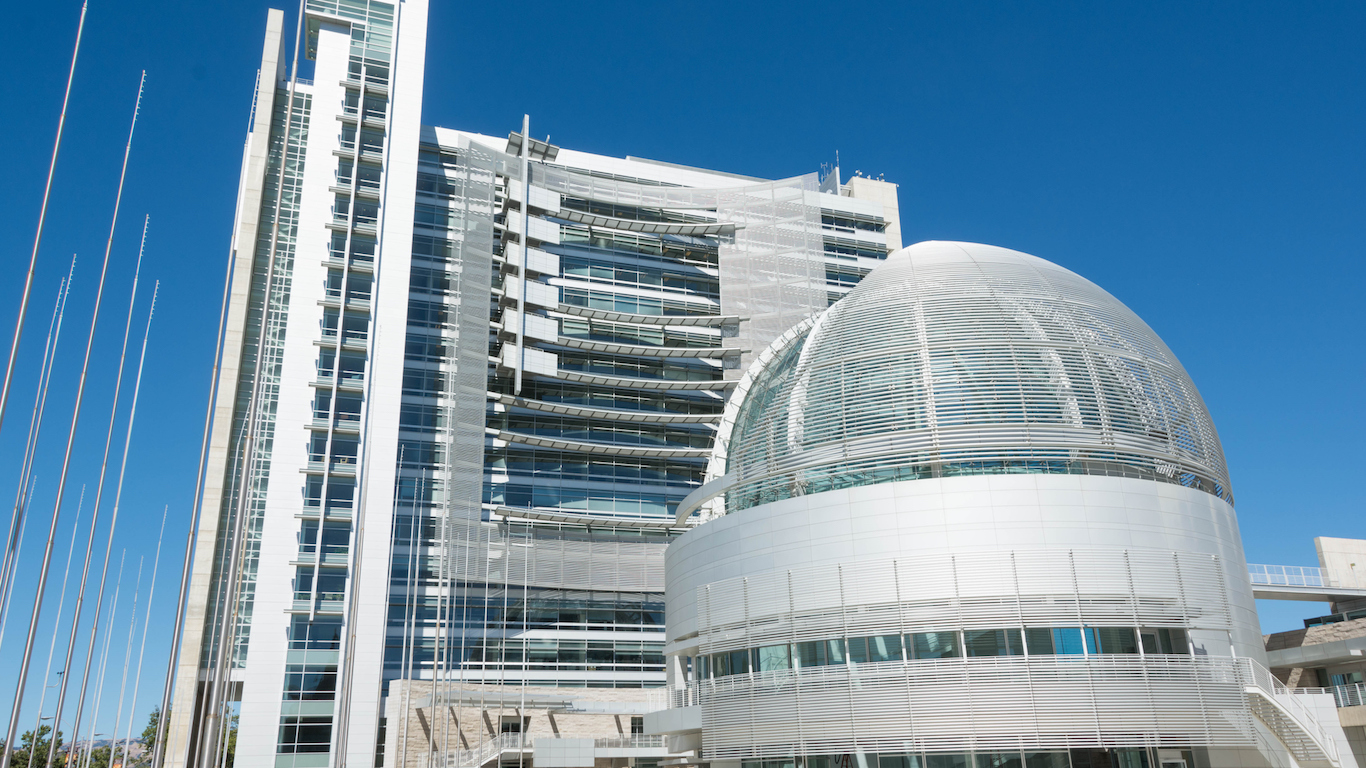
1. San Jose-Sunnyvale-Santa Clara, CA
> Advanced industries, share of employment: 31.2%
> Advanced industries, share of output: 51.4%
> Annual avg. wage: $116,734
> Largest advanced industry: Computer systems design
The San Jose metropolitan area is far and away the largest advanced industry employer, with such industries accounting for nearly one-third of all employment in the area. Over half of the metro’s GDP is is attributable to the area’s high tech industry — nowhere else is this the case. Silicon Valley, a hotbed of the nation’s high tech activity, is also a source of a high level of innovation. In 2015, 740 patents were awarded for every 100,000 area residents, several times greater than second-place San Francisco-Oakland-Hayward, where 209 patents were awarded per 100,000 people. Well known corporations such as Adobe Systems, Apple, Cisco Systems, eBay, HP, Intel, Microsoft, Nasa, and many others are all major employers in the area.
The dominance of the tech industry has contributed to some of the nation’s — if not the world’s — highest-paying jobs. The average San Jose area resident employed in the tech industry earns over $200,000 annually, and the average wage for all employees of $116,734 is the highest of any U.S. metro area.
Start by taking a quick retirement quiz from SmartAsset that will match you with up to 3 financial advisors that serve your area and beyond in 5 minutes, or less.
Each advisor has been vetted by SmartAsset and is held to a fiduciary standard to act in your best interests.
Here’s how it works:
1. Answer SmartAsset advisor match quiz
2. Review your pre-screened matches at your leisure. Check out the advisors’ profiles.
3. Speak with advisors at no cost to you. Have an introductory call on the phone or introduction in person and choose whom to work with in the future
Thank you for reading! Have some feedback for us?
Contact the 24/7 Wall St. editorial team.